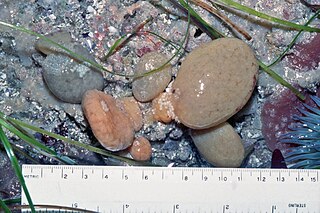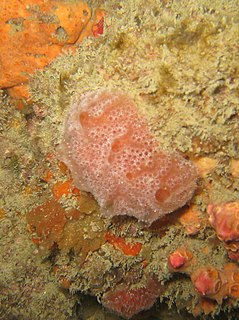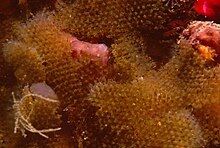
Bryozoa are a phylum of aquatic invertebrate animals. Typically about 0.5 millimetres long, they are filter feeders that sieve food particles out of the water using a retractable lophophore, a "crown" of tentacles lined with cilia. Most marine species live in tropical waters, but a few occur in oceanic trenches, and others are found in polar waters. One class lives only in a variety of freshwater environments, and a few members of a mostly marine class prefer brackish water. 5869 living species are known. One genus is solitary and the rest are colonial.

Entoprocta, whose name means "anus inside", or Kamptozoa, is a phylum of mostly sessile aquatic animals, ranging from 0.1 to 7 millimetres long. Mature individuals are goblet-shaped, on relatively long stalks. They have a "crown" of solid tentacles whose cilia generate water currents that draw food particles towards the mouth, and both the mouth and anus lie inside the "crown". The superficially similar Bryozoa (Ectoprocta) have the anus outside a "crown" of hollow tentacles. Most families of entoprocts are colonial, and all but 2 of the 150 species are marine. A few solitary species can move slowly.

Cheilostomatida is an order of Bryozoa in the class Gymnolaemata.

Membranipora membranacea is a very widely distributed species of marine bryozoan known from the Atlantic and Pacific Oceans, usually in temperate zone environments. This bryozoan is a colonial organism characterized by a thin, mat-like encrustation, white to gray in color. It may be known colloquially as the sea-mat or lacy crust bryozoan and is often abundantly found encrusting seaweeds, particularly kelps.

Cyclostomatida, or cyclostomes, are an ancient order of stenolaemate bryozoans which first appeared in the Lower Ordovician. It consists of 7+ suborders, 59+ families, 373+ genera, and 666+ species. The cyclostome bryozoans were dominant in the Mesozoic; since that era, they have decreased. Currently, cyclostomes seldom constitute more than 20% of the species recorded in regional bryozoan faunas.
In the bryozoan order Cheilostomata, the operculum is a calcareous or chitinous lid-like structure that protects the opening through which the polypide protrudes.

Phoronids are a small phylum of marine animals that filter-feed with a lophophore, and build upright tubes of chitin to support and protect their soft bodies. They live in most of the oceans and seas, including the Arctic Ocean but excluding the Antarctic Ocean, and between the intertidal zone and about 400 meters down. Most adult phoronids are 2 cm long and about 1.5 mm wide, although the largest are 50 cm long.

Flustra foliacea is a species of bryozoans found in the northern Atlantic Ocean. It is a colonial animal that is frequently mistaken for a seaweed. Colonies begin as encrusting mats, and only produce loose fronds after their first year of growth. They may reach 20 cm (8 in) long, and smell like lemons. Its microscopic structure was examined by Robert Hooke and illustrated in his 1665 work Micrographia.

Pyrosoma atlanticum is a pelagic species of marine colonial tunicate in the class Thaliacea found in temperate waters worldwide. The name of the genus comes from the Greek words pyros meaning 'fire' and soma meaning 'body', referring to the bright bioluminescence sometimes emitted. The specific epithet atlanticum refers to the Atlantic Ocean, from where the first specimen of the species was collected for scientific description; it was described in 1804 by François Péron, a French naturalist.

Didemnum vexillum is a species of colonial tunicate in the family Didemnidae. It is commonly called sea vomit, marine vomit, pancake batter tunicate, or carpet sea squirt. It is thought to be native to Japan, but it has been reported as an invasive species in a number of places in Europe, North America and New Zealand. It is sometimes given the nickname "D. vex" because of the vexing way in which it dominates marine ecosystems when introduced into new locations, however the species epithet vexillum actually derives from the Latin word for flag, and the species was so named because of the way colonies' long tendrils appear to wave in the water like a flag.
Amathia vidovici is a species of colonial bryozoans with a tree-like structure. It is found in shallow waters over a wide geographical range, being found in both the Atlantic and Pacific Oceans and adjoining seas.
Zoobotryon verticillatum, commonly known as the spaghetti bryozoan, is a species of colonial bryozoans with a bush-like structure. It is found in shallow temperate and warm waters in the western Atlantic Ocean and the Caribbean Sea and has spread worldwide as a fouling organism. It is regarded as an invasive species in some countries.
Conopeum seurati is a species of colonial bryozoan in the order Cheilostomata. It is native to the northeastern Atlantic Ocean, the North Sea and the Mediterranean Sea. This species has been introduced to New Zealand and Florida.

Electra pilosa is a species of colonial bryozoan in the order Cheilostomata. It is native to the northeastern and northwestern Atlantic Ocean and is also present in Australia and New Zealand.

Polyclinum planum, is a compound ascidian commonly known as the Elephant Ear Tunicate. It is an ascidian tunicate in the family Polyclinidae. Ascidians are also known as sea squirts.

Cryptosula pallasiana is a species of colonial bryozoan in the order Cheilostomata. It is native to the Atlantic Ocean where it occurs in northwestern Europe and northern Africa, and the eastern seaboard of North America. It has been accidentally introduced to the western coast of North America and to other parts of the world.

Watersipora subtorquata, commonly known as the red-rust bryozoan, is a species of colonial bryozoan in the family Watersiporidae. It is unclear from where it originated but it is now present in many warm-water coastal regions throughout the world, and has become invasive on the west coast of North America and in Australia and New Zealand.

Aplidium elegans (sea-strawberry) is a species of colonial sea squirt, a tunicate that is a benthic invertebrate in the family Polyclinidae and class Ascidiacea. It is native to shallow waters in the Atlantic Ocean and Mediterranean Sea. It is also found in between France and the United Kingdom.

Electra posidoniae is a species of bryozoan in the family Electridae. It is endemic to the Mediterranean Sea, and is commonly known as the Neptune-grass bryozoan because it is exclusively found growing on seagrasses, usually on Neptune grass, but occasionally on eelgrass.
Callopora lineata is a species of colonial bryozoan in the family Calloporidae. It is found on rocky shores in the Atlantic Ocean and the Mediterranean Sea.















